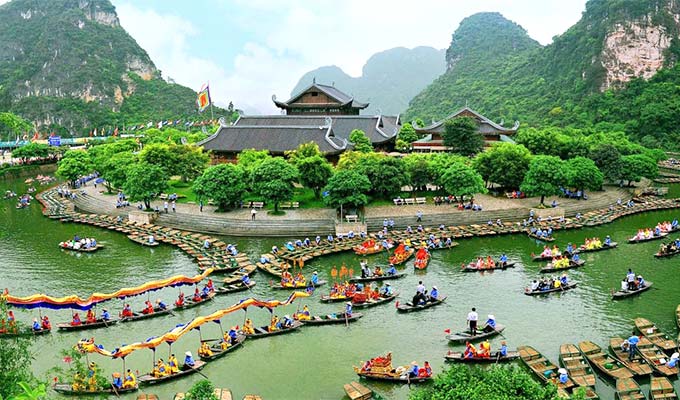The northern province of Ninh Binh will have opportunities to promote its tourism potential as a cultural, sport and tourism festival will be held in the locality later this month.

Held by the Ministry of Culture, Sports and Tourism, the event is part of the programmes organised to mark 1,050th anniversary of Dai Co Viet, the first feudal state of Viet Nam.
A wide range of cultural activities are scheduled such as photo exhibitions, amateur cheo (traditional opera) performances, and various culture and sport activities.
Local Trang An Landscape Complex, recognised by the UNESCO as a World Heritage site in 2014, together with other renowned heritages like Ha Long Bay, Phong Nha Ke Bang National Park, and gong cultural space in the Central Highlands, among others, will be nudged closer to the visitors at the festival through the “Going through the heritages of Viet Nam” photo exhibition.
Also, the exhibition, with 100 gorgeous photos, will feature stunning natural landscapes, architecture, historical and cultural relic sites, as well as typical cultural characteristics of ethnic groups across the country.
Located about 90 kilometres south of Ha Noi, Ninh Binh is known as “Ha Long Bay on Land”, given its limestone mountains rising out of paddy fields. The most famous local attraction is the Trang An Landscape Complex with a total of 40 tourism spots of historical, cultural, art and natural vestiges including 20 recognised as national heritages.
In UNESCO’s words, "Trang An is a resplendent complex of limestone karst peaks which are permeated with valleys, including submerged ones, and surrounded by steep, almost vertical cliffs".
Together with other famous sites in the province such as Tam Coc Grottos and Van Long Lagoon, the Trang An Landscape Complex was also used as a location for the movie Kong: Skull Island, one of the biggest Hollywood blockbusters of 2017.
The locations opened to tourists last April.
The province has been listed as one of the 50 best spots to visit in 2018 by US travel site Insider.
Ninh Binh is striving to become one of the tourism hubs of Viet Nam by 2020 and to turn tourism into a spearhead industry of the local economy by 2030. This is the goal of the province’s master plan on tourism development until 2025, with a vision to 2030.
Ninh Binh looks to attract 1 million foreign arrivals and 7 million domestic visitors by 2020, 1.5 million and 9 million by 2025, and 2.1 million and 11.2 million by 2030. Meanwhile, tourism revenue is expected at over 4.2 trillion VND (179.7 million USD), 11.8 trillion VND (504.8 million USD), and 27 trillion VND (1.15 billion USD), respectively.
Under the plan, the province will turn Ninh Binh city into the main tourism centre while Tam Diep city and townships in Hoa Lu, Gia Vien, Nho Quan, Yen Mo, Yen Khanh and Kim Son districts will be developed into supporting centres.
The Trang An Landscape Complex and the Kenh Ga – Van Trinh national tourist area will continue to be improved to deserve their national status. Six provincial tourist areas and more places of interests will also be formed in the coming years.
To realise this plan, Ninh Binh is set to ask for the Government and relevant ministries’ permission to apply some special preferential policies to attract investment to tourism.
Provincial authorities also called on the Ministry of Culture, Sports and Tourism to further include local tourism information in promotion programmes for Vietnamese tourism and support Ninh Binh in training human resources, expanding markets and products, and protecting the environment.
According to the provincial Department of Tourism, Ninh Binh welcomed more than 7 million visitors and earned over 2.5 trillion VND (107 million USD) from this industry in 2017, respectively rising by 9.5 percent and 43 percent year on year.
In the last eight months, over 6 million vacationers chose Ninh Binh as their destination, helping the province gain 2.3 trillion VND (98.4 million USD) in tourism revenue, up 5 percent and 18.8 percent from the same period last year, respectively.